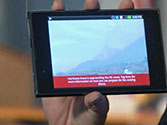
WRAL-TV demonstrates the Mobile Emergency Alert System. |
On Thursday, September 13, 2012, WRAL became the first commercial television station in the nation to demonstrate a new technology called the Mobile Emergency Alert System.
Once it is fully developed and deployed, M-EAS will offer emergency responders and the media a new way to communicate with the public in a crisis. It could save lives.
When a natural disaster or terrorist attack occurs, millions of people turn first to their cellphone – to find out what is going on and to check on loved ones. All those calls, text messages and web searches have been shown to clog cellphone networks. That’s what happened after an earthquake rocked the eastern seaboard in 2011. People in Raleigh reported outages of 30 minutes or more.
“It’s a fragile system. It can get clogged. It can be overwhelmed,” said Sam Matheny, vice president, Policy & Innovation at Capitol Broadcasting Company, Inc., the parent of WRAL-TV.
 |
| WRAL’s Debra Morgan holds a mobile broadcast receiver capable of showing data from the Mobile Emergency Alert System. |
 |
Matheny says M-EAS would be a better way to share important information during emergencies, like hurricanes, tornadoes and earthquakes.
Instead of using the Internet or cell phone networks, broadcasters can use a special digital TV signal to send alerts to your smart phone or other mobile device.
“Because it’s being broadcast, it’s one to many. It can reach an infinite number of people,” Matheny said.
Broadcasters will be able to send text alerts, web pages full of emergency information and even videos.
Matheny said a similar alert system using digital TV signals worked well during last year’s earthquake and tsunami in Japan. That disaster knocked 13,000 cell towers offline, but people still received emergency information on their phones, using Japan’s version of the digital TV alert system.
Matheny says their experience shows that when disaster strikes in the future, the Mobile Emergency Alert System can save lives.
The M-EAS technology still is being developed. It could be a couple of years before it’s available to the public.
Thanks to WRAL-TV’s Debra Morgan, WRAL-TV’s Brian Shrader, WRAL-TV’s Richard Adkins and WRAL.com’s Jodi Glusco for this capcom story & these capcom photos.